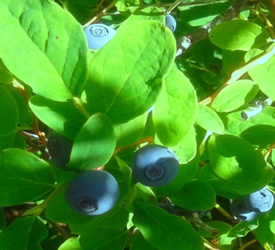Blueberry

Botanical Name: Vaccinium ovalifolium
Common Name: Blueberry
Other Names: atsut, atsaq (berry)
Found in: Throughout Alaska, except for the extreme north Arctic, from thickets, woods, and moist meadows to bogs.
Physical Characteristics: Oval-leaf blueberry bush can grow up to 15 feet high; Leaves are oval with smooth margins; Fruits are purple to blue-black, very sweet and tasty; Oval-leaf blueberry flowers early; Bell-shaped flowers are typical, color varies from pink to white; Fruits have a whitish bloom.
Nutritional Value: Vitamins A, C, E, K, riboflavin, folate (vitamin B9), calcium, iron, magnesium, phosophorus, potassium, sodium.
Parts of the plant used: Berries and leaves
When plant should be gathered: leaves should be collected before the fruits ripen; berries are ripe in late July - August
Plant applications: food and tea, dye
Reported Benefits: Some have used blueberries as an anti-inflammatory and antioxidant. May help regulate blood pressure, and control bad cholesterol. May improve motor skills and help reverse short term memory loss.
Preparation/Processing: In earlier days, people frequently ate berries raw, as they do today. In the past they commonly mixed them with seal oil while today sugar is often used. This mixture would be stored in a tightly closed seal stomach container or in a wooden barrel for two or three months. The containers were kept in a cool place or in a pit cache under the floor below the table in the main house. Berries were dried in the past, often on roofs and were stored in above ground caches in round spruce bark containers.
With the arrival of sugar, people learned to make jams, jellies, pies, cakes and other modern dishes with berries. Before commercial freezers were available, people would pack berries in layers of sugar to preserve them.
Young leaves and flowers of berry plants serve as emergency food as do the tips of the berry branches.
WARNING: Blue berry leaf tea, in large doses can cause nausea and vomiting.
